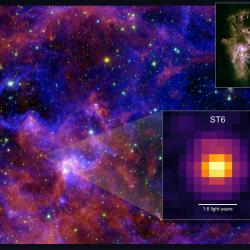Early Earth Had a Hazy, Methane-filled Atmosphere
Thick clouds of methane forced hydrogen to leave the atmosphere, enabling today’s oxygen-rich air to develop
More than 2.4 billion years ago, Earth’s atmosphere was inhospitable, filled with toxic gases that drove wildly fluctuating surface temperatures. Understanding how today’s world of mild climates and breathable air took shape is a fundamental question in Earth science.
 New research led by the University of St. Andrews with contributions from the University of Maryland, NASA’s Jet Propulsion Laboratory, the University of Leeds and the Blue Marble Space Institute of Science suggests that long ago, Earth’s atmosphere spent about a million years filled with a methane-rich haze. This haze drove a large amount of hydrogen out of the atmosphere, clearing the way for massive amounts of oxygen to fill the air. This transformation resulted in an atmosphere much like the one that sustains life on Earth today.
New research led by the University of St. Andrews with contributions from the University of Maryland, NASA’s Jet Propulsion Laboratory, the University of Leeds and the Blue Marble Space Institute of Science suggests that long ago, Earth’s atmosphere spent about a million years filled with a methane-rich haze. This haze drove a large amount of hydrogen out of the atmosphere, clearing the way for massive amounts of oxygen to fill the air. This transformation resulted in an atmosphere much like the one that sustains life on Earth today.
The group’s results, published March 13, 2017 in the early online edition of the Proceedings of the National Academy of Sciences, propose a new contributing cause for the Great Oxidation Event, which occurred 2.4 billion years ago, when oxygen concentrations in the Earth’s atmosphere increased more than 10,000 times.
“The transformation of Earth’s air from a toxic mix to a more welcoming, oxygen-rich atmosphere happened in a geological instant,” said James Farquhar, a professor of geology at UMD and a co-author of the study. Farquhar also has an appointment at UMD’s Earth System Science Interdisciplinary Center. “With this study, we finally have the first complete picture of how methane haze made this happen.”
The researchers used detailed chemical records and sophisticated atmospheric models to reconstruct atmospheric chemistry during the time period immediately before the Great Oxidation Event. Their results suggest that ancient bacteria—the only life on Earth at the time—produced massive amounts of methane that reacted to fill the air with a thick haze, resembling the modern-day atmosphere of Saturn’s moon Titan.
Previous studies by many of the same researchers had identified several such haze events early in Earth’s history. But the current study is the first to show how rapidly these events began and how long they lasted.
“High methane levels meant that more hydrogen, the main gas preventing the build up of oxygen, could escape into outer space, paving the way for global oxygenation,” said Aubrey Zerkle, a biogeochemist at the University of St. Andrews and a co-author of the study. “Our new dataset constitutes the highest resolution record of Archean atmospheric chemistry ever produced, and paints a dramatic picture of Earth surface conditions before the oxygenation of our planet.”
The methane haze persisted for about a million years. After enough hydrogen left the atmosphere, the right chemical conditions took over and the oxygen boom got underway, enabling the evolution of all multicellular life.
The key to the researchers’ analysis was the discovery of anomalous patterns of sulfur isotopes in the geochemical records from this time. Sulfur isotopes are often used as a proxy to reconstruct ancient atmospheric conditions, but previous investigations into the time period in question had not revealed anything too unusual.
“Reconstructing the evolution of atmospheric chemistry has long been the focus of geochemical research,” said Gareth Izon, lead author of the study, who contributed to the research while a postdoctoral researcher at St. Andrews and is now a postdoctoral researcher at the Massachusetts Institute of Technology. “Our new data show that the chemical composition of the atmosphere was dynamic and, at least in the prelude to the Great Oxidation Event, hypersensitive to biological regulation.”
###
This release is based on text provided by the University of St. Andrews.
The research paper, “Biological regulation of atmospheric chemistry en route to planetary oxygenation,” Gareth Izon, Aubrey Zerkle, Kenneth Williford, James Farquar, Simon Poulton, and Mark Claire, was published March 13, 2017 in the Proceedings of the National Academy of Sciences.
This work was supported by the Natural Environment Research Council (Award Nos. NE/H016805 and NE/J023485), the Scottish Alliance for Geoscience, Environment and Society, The Geological Society of London’s Alan and Charlotte Welch Fund, NASA (Award No. NNX12AD91G), The Royal Society, and the European Research Council (Award No. 678812). The content of this article does not necessarily reflect the views of these organizations.
Media Relations Contact: Matthew Wright, 301-405-9267, mewright@umd.edu
University of Maryland
College of Computer, Mathematical, and Natural Sciences
2300 Symons Hall
College Park, MD 20742
www.cmns.umd.edu
@UMDscience
About the College of Computer, Mathematical, and Natural Sciences
The College of Computer, Mathematical, and Natural Sciences at the University of Maryland educates more than 7,000 future scientific leaders in its undergraduate and graduate programs each year. The college's 10 departments and more than a dozen interdisciplinary research centers foster scientific discovery with annual sponsored research funding exceeding $150 million.







